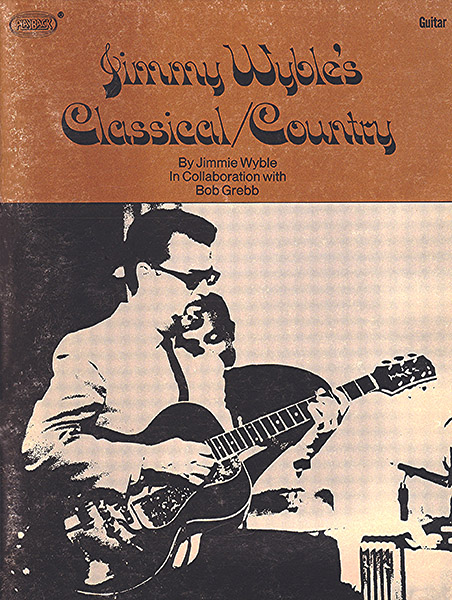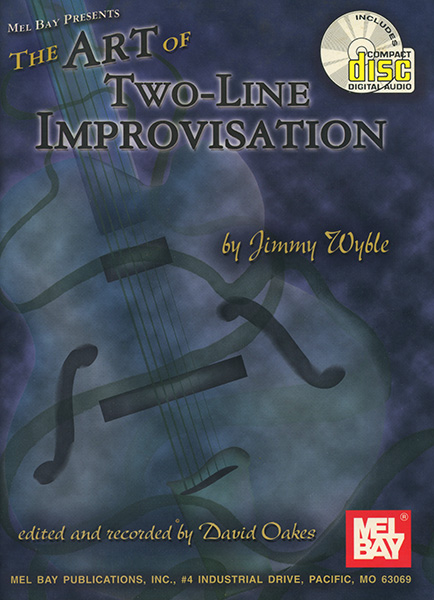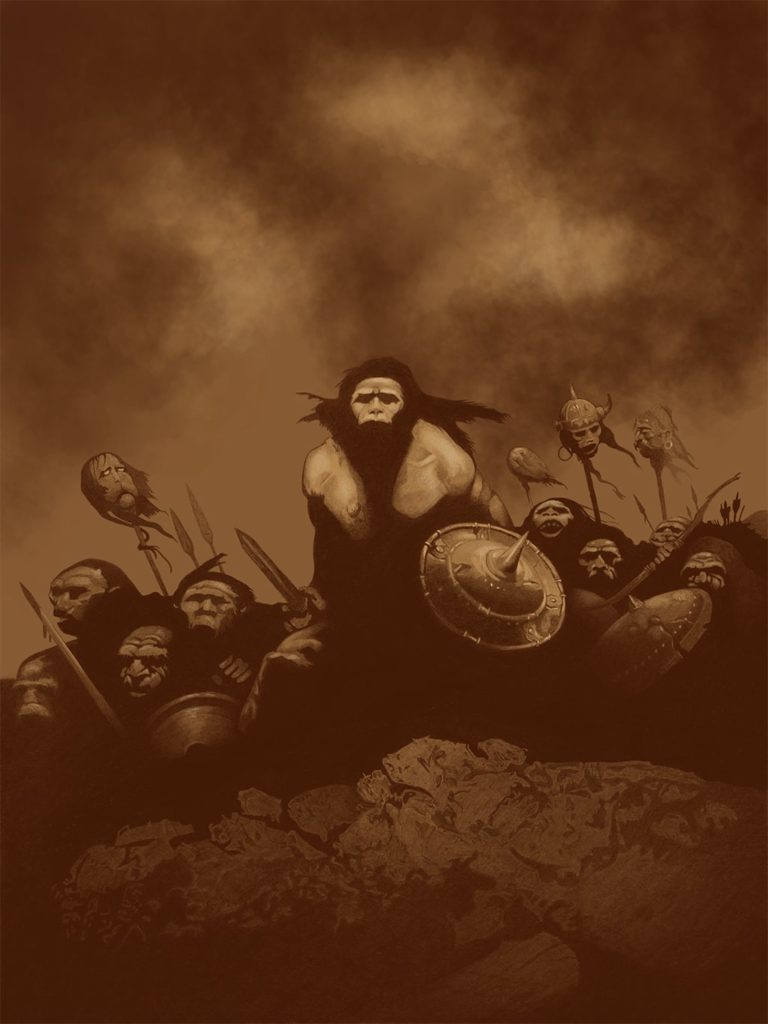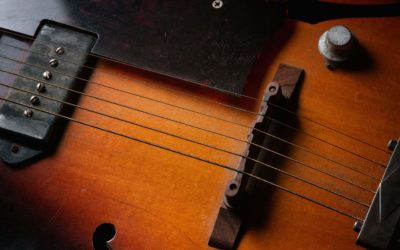Table of Contents
Book Review: The Art of Two-Line Improvisation
Jimmy Wyble’s “The Art of Two-Line Improvisation” is considered by many to be a classic. Let’s take a look at what this book has to offer to the Contrapuntal guitarist.
Jimmy Wyble’s Classical Country

While this review is primarily about “The Art of Two-Line Improvisation”, we must first take a look at the book that Wyble wrote to first explore this technique. Written in 1973, this 50 page book is the first to present Wyble’s harmonic and technical approach to Contrapuntal playing. He first lays down the theoretical aspects of the harmony/melody before introducing the section on “Exercises in Sound”, which is the basis of the Etudes written for the rest of the book. For those familiar with “The Art of Two-Line Improvisation”, you will recognize Wyble’s concepts introduced here.
The Art of Two-Line Improvisation (Original Edition)
When I was first became aware of this book, it was a rare and very difficult to find book (it featured a black and white cover). It was not surprising to see copies going for $100 on eBay. Fortunately I was able to get a copy for a bit less than that, but all in all, it did take quite a while to find a copy available for sale. And while I was ecstatic to finally obtain a copy, there was a problem with some of the Etudes, in terms of incorrect notes in the transcriptions. Nonetheless, from a technical viewpoint there was a lot of interesting, and varied, material throughout.
The Art of Two-Line Improvisation w/ Compact Disc (Mel Bay)

Fortunately, Mel Bay Publications revised the original version, correcting the mistakes and such, as well as releasing a companion CD of the etudes, performed by guitarist David Oakes. Needless to say, when this was announced I quickly sold my original copy and waited for the release of the new version, which I promptly picked up the week it was released. I’m happy to say that this version is excellent and I will be using this as the basis of my review.
Kudos
The 90+ page book starts with a flattering collection of quotes offered by many of guitar’s most illustrious solo jazz players. Names such as Joe Pass, Ted Greene, Joe Diorio, Ron Eschete, John Stowell and others comment on Wyble’s playing and compositions.
Examples
Although not as extensive as “Classical Country”, there is a section that features 23 examples that are to prepare you for the Etudes which follow. These are primarily studies that feature one line moving in steady eighth notes, while the other line is in quarter notes. None of the theory, “sounds” and other text that previously appeared in “Classical Country” appear here. This is not really a problem, as most players who attempt this material will gain an understanding of the concepts by playing these examples.
Scales and Sounds
It should be noted, that the pieces are not diatonically based on Major scales. This is my only complaint with the book, as the material isn’t as useful as it could have been, since you are unable to directly “lift” phrases/ideas from the Etudes to incorporate into you own playing. For instance, the aforementioned exercises and Etudes 17 and 20 use a scale that the original edition analyzed as a Major scale with a b3, #4 and #5. It is sounds such as this that give many of the Etudes their unique sound, yet makes them less useful for standard diatonic harmonies.
Etudes
This book features Wyble’s Etudes numbered from 7-25. Etudes 1-6 appear in “Classical Country”. There is a wide range of material presented here. I found that there were songs that were enjoyable to play and listen to, and some that I had less interest in. Nevertheless, they all contain useful techniques and concepts to add to your Contrapuntal playing. Several of the pieces are dedicated to specific players such as Red Norvo, Fats Waller, Louis Armstrong and others, while Alec Wilder has three Etudes dedicated to him. I remember that Etude #12 (Red Norvo) was always one of my favorites to play. (See below)
And while I enjoyed Etude #12, there are several that are a bit too “dissonant” for my taste these days. One downside of the materials presented is that a lot of it is hit or miss, depending on your ears and purpose for playing them. While I could see playing a couple of these in a solo setting, I tend to think that most of them would not suitable for some settings. However, they are all useful for learning concepts that perhaps you can adjust for your own compositional/arranging style.
Since the material is so unique, it is feasible to study a handful of the Etudes and walkaway with an understanding on how Wyble approached the material from both a harmonic and technical usage. One of the best uses of the CD is to listen to it and pick out the songs that are interesting to you and delve into those.
After the Etudes there are several pages devoted to “Improvisation Part 1” and “Improvisation Part 2”. These feature the same sounds and techniques that were introduced in the Etudes, but this time Wyble just improvises the lines, which were then transcribed for the book. These are in the same improvisational spirit of Ted Greene’s Baroque improvs, but clearly they sound totally different.
CD
The one thing that really makes this edition of the book stand out is the inclusion of a Compact Disc of all the material. This not only allows you to listen to it and pick out the pieces you want to learn, but it also provides the opportunity to hear them performed in a stellar manner by guitarist David Oakes. Another use of the CD is to put it on and just listen to it and absorb the sounds. Although I do enjoy listening to the CD on it’s own, most times I get a bit tired of hearing that same harmonic sound and find myself wanting to listen to something else. Yet, in small doses, I love hearing many of the pieces.
Here is David Oakes performing Etude #12 (To Red Norvo):
David Oakes Website Resources
David Oakes’s website features many resources that are available to peruse and download. If Jimmy Wyble or this approach to Contrapuntal playing is something that interests you, then you will want to check out the many items that he has for study on his page. This includes Etudes 1-6 from the “Classic Country” book, an interview with Jimmy Wyble, as well as primers, Contrapuntal Concepts and a lot more! Lots of good material and insights!
http://www.davidoakesguitar.com/jimmyTribute.php
Summary
For many years this was the only book available for improvising two lines on the guitar. It is still highly relevant today and for those who have not played this material, it is a must. And while “Classical Country” is the birthplace of this concept, it is not necessary in order to study this material. Due to the amount of material, I’m sure that you’ll find at least a couple of pieces that you will find enjoyable. And for those who like a healthy dose of “altered harmony” in their playing, then you will find many pieces that you will want to add to your repertoire.
I’ve been toying with the idea of going through this book again, this time mapping out the material on my Hybrid 7 guitar and seeing how it turns out. It sounds great on my Ramirez classical guitar, and with the separate bass/guitar outputs on the Hybrid 7, it should sound interesting with actual bass notes being sounded in the lower lines!
This is one of those “must have” books for those interested in Contrapuntal playing. Working through this material will certainly yield results. Of course, then it is up to you to take the concepts and apply them to your own compositions and improvisations!
Highly Recommended
Final Words
I’d like to take a moment to thank everyone who has purchased my book! In these crazy times, I appreciate your interest and support!
As mentioned in my last post, I’ve been splitting my time between 3-4 hours of guitar practice and 3-4 hours of drawing practice. For fun, I’ve again enclosed a recent master study drawing that I did of Frank Frazetta’s “Bran Man Morn” painting, using Procreate on an iPad Pro, using an Apple Pencil 2.






I admire the useful information and facts you provide in your content. I will bookmark your weblog and also have my kids examine up right here normally. I am very certain theyll learn a lot of new stuff here than anyone else!